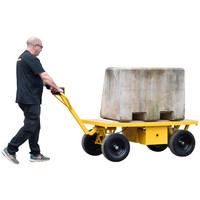9th Mar 2022
UDL stands for Uniformly Distributed Load, and in general terms means that the load is evenly spread out across whatever platform is supporting it. With trolleys specifically, this usually means that the weight is evenly supported by all wheels, whether that's two wheels of a sack truck, 4 wheels of a turntable trolley, or 6 or more wheels on some of the more specialised trolleys.
Why is UDL Important?
UDL is important because without it, some equipment become unsafe to use. If the entire weight of a load is focussed on one point, that point will be under far greater stress than the rest of the supporting platform. This is especially important with trolleys, as weight is meant to be evenly distributed across all wheels. Most trolleys weight capacity is based on the total capacity of three of the wheels.
How do I know the UDL Capacity on my trolleys?
It should be marked clearly on the trolley and somewhere that is easily visible. At Handle-iT all trolleys are despatched with a UDL Capacity Sticker, ensuring that the operator knows the safe working limit of the trolley and how much should be loaded on it. Just because the trolleys have a SWL (Safe Working Load) or UDL capacity it doesn't mean that it has to be loaded to that weight, where ever possible you should always work to sensible loads, and most importantly safe for the operator. Just because the trolleys can move 500kg, can the operator? These elements are all explained and highlighted in the risk assessments provided for the products you have purchased ensuring safety at all times
What if my trolley doesn't have a UDL Capacity Sticker?
The best way to get an accurate UDL sticker is to speak to the original supplier or manufacturer. For some products, this might not be possible. If you cannot find the original manufacturer, they are no longer available, or if they simply don't have the answers you're looking for, feel free to send us a picture of the unit in question and we can try and deduce this as accurately as we can for you.
What if I overload the trolley?
If you're working safely, this should NEVER happen. Our trolleys and sack trucks have all been overloaded on test to ensure a safe working load, but this safety buffer exists to grant tolerances for uneven ground, pick weight errors, collisions, and other accidents. Everything is over tested by 50% of the stated load with three, four and six wheeled trolleys and with sack trucks and barrows to the capacity + 25%. This is just as an additional layer of safety, and is standard practice throughout our company and the load testing world. However not all companies are quite as honest. We see sack barrows that can't possibly take the weights shown in adverts. We have highlighted some of these issues here, however not all companies follow our safety standards and if you do overload a competitor truck or trolley you are running a serious risk of personal injury.
What else do you need to know?
I remember being at school as a kid, and being show the leverage principle, I know I have always been boring, but you would have likely experienced something similar. Back in the day, the way we were taught was to hold a broom at the head end of the brush, it felt so light and easy to hold. Then the further your hand retracted down the handle of the broom, the heavier the brush felt, to the point where you could not keep the head of the brush in the air any longer and the head of the brush fell to the floor, this is because we have adjusted the loads 'Centre of Gravity' (CoG) of what you are trying to hold.
This is a very basic way of explaining how a sack truck or sack barrow will act as a fulcrum, with the wheel being almost like the balance point on a seesaw.
These principles must always be considered when using a sack truck or barrow, so please do consider not only is the truck capable of carrying the load, but is the operator capable of counterbalancing the weight on the front of the barrow? Additionally, if the load centres have been pushed forward then this must be offset. Ultimately caution is the key to this being a safe operation.
